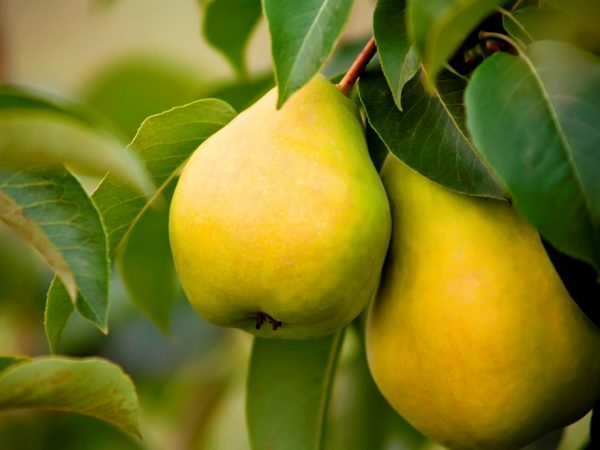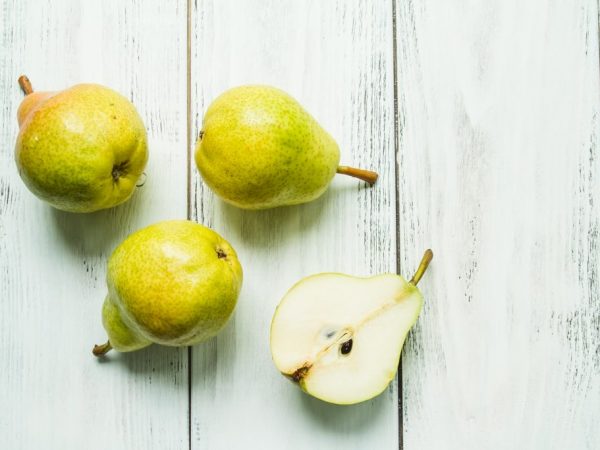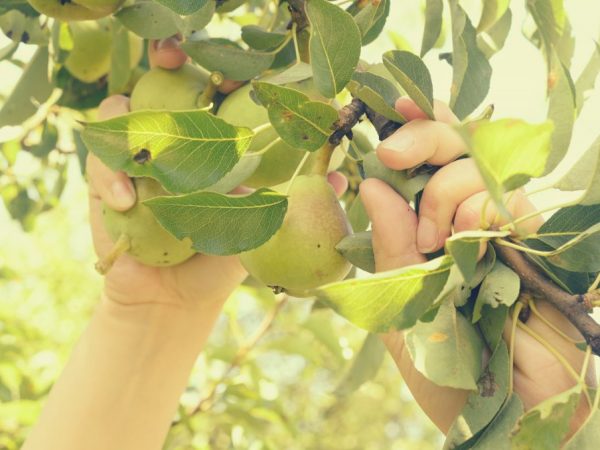Characteristics of the honey variety pear
Honey pear is distinguished by its early maturity and high yield. Fruits of this variety have a pronounced sweet taste and have a marketable appearance.

Characteristics of the honey variety pear
Variety characteristics
Description of the honey pear variety:
- fruits are formed in 3-5 years;
- early maturity with a dwarf carriage;
- the variety bears fruit in the second half of autumn.
This variety is partially self-pollinated, but several pollinating trees should be planted each year to produce a harvest. Suitable varieties include:
- Miracle woman;
- Bere Bosk;
- Bere Ardanpon.
The flowering of these pears coincides with the flowering of the Honey variety. Also, crops bear fruit at the same time.
The species is suitable for planting in regions with a temperate and warm climate. The variety is used in cooking and canned for the winter. The fruits are not suitable for freezing.
Description of the tree
The height of the tree reaches 2 m. The crown has a pyramidal shape and grows rapidly. The foliage density is average. The ovaries are found on fruit and ringed branches. The small size of the trees allows it to be planted in a small area.
Description of fruits
Fruits of the Crimean Honey type have a number of standards for appearance and consistency. Among the characteristics are:
- fruit weight - from 400 to 500 g;
- the proportion of sugars - 15%;
- 100 g of pulp contains 6 mg of vitamin C.

Fruits are ribbed, yellow-green
The shape of the fruit is pear-shaped and unequal. The surface is covered with small tubercles. Weak ribbing is observed. Fruit color is yellow-green.
The pulp is juicy, beige in color with a pronounced aroma. The taste is sweet and tart. Also, the fruits have a large amount of useful essential oils, so they are used to enhance immunity. The variety is used in cooking and canned for the winter. The fruits are not suitable for freezing.
Care
To obtain a good harvest of the Crimean Honey Pear, it is necessary to follow the rules of planting and care.
- watering mode;
- top dressing;
- pruning the crown.
Watering
Watering frequency depends on the season. For spring planting, seedlings must be watered once every 3 days. In hot weather, soil irrigation is carried out daily. Shoots planted in autumn are watered once at planting. Watering rate - 2 buckets for one year of plant life.
It is best to irrigate a pear by sprinkling. If this is not possible, you should carefully add water under the root of the tree in several passes.
Loosening
After watering and precipitation, the soil in the hole should be loosened to avoid the formation of a hard earthen crust. Also, the hole must be mulched. This will allow the roots to retain moisture for longer.
Fertilizer
In the first year after planting, the crop is not fertilized. In the second year, it is necessary to add organic and mineral components. The mixture should contain 0.5% nitrogen, 0.3% potassium and 0.3% phosphorus. 1-2 kg of fertilizer is applied under one tree, which should be thoroughly mixed with the ground. Nitrogen is used only in spring, because already in summer the culture is preparing for wintering and active growth can adversely affect the pear.
It is also necessary to carry out foliar feeding. Before the formation of flowers, the pear is sprayed with a 2% superphosphate solution. This will increase the yield of the variety. The urea solution will help strengthen the culture. The desired concentrate should be 2% of the total liquid. Such spraying is carried out two weeks after the beginning of flowering.
Acidic soil can cause a pear to lack calcium. To avoid this, it is necessary to sprinkle the soil with ash. 3-4 glasses are used for 1 m². The soil is processed in a similar way at the end of August.

To get a good harvest of the Crimean Honey Pear, you must follow the rules of planting and care
Formation
Pruning is best done at the end of March. During this period, the movement of the sap is slowed down and the formation of the crown will not injure the tree. Pruning depends on the age of the tree. Saplings in the first year do not need crown formation. In the second year, the first tier of the crown is formed. To do this, leave two or three well-developed branches, the rest are cut off in a ring. Pruning is done with sharp garden shears. Without such a procedure, the crown will begin to grow unevenly, which will affect the quality of the fruit.
Particular attention should be paid to the first flowering after planting. The flowers must be removed so that the pear has enough strength to take root in the new area.
Diseases and pests
The Krymskaya Medovaya variety is resistant to the main diseases of fruit trees - fruit rot and perforated leaf spot. However, there are a number of diseases the prevention of which is necessary for the variety:
- Scab - spots on the surface of the leaves of olive color. The disease is vulnerable to 3% Bordeaux solution. You can also treat flowering with Horus - 2 grams per 10 liters of water.
- Rust is a disease affecting foliage. It appears as reddish spots. Prevention includes the treatment of the crown with the drug Skor in proportions of 2 ml per 5 liters of water.
- Moniliosis is a fungal disease that affects fruits. The disease is prevented with the help of the drug Dnok - it is necessary to dilute 100 g of 10 liters of water with the solution. The dormant kidneys must be treated with the solution.
Many insects can also damage crops. Among them, it is especially possible to highlight the sucker and aphids. These insects feed on the sap of leaves and fruits, damaging the crown and fruits. To avoid losses, it is necessary to remove moss and old bark from tree trunks. You should also cut off diseased branches and dig up the trunk circles.
Whitewashing the trunk will help get rid of many harmful insects.
If the pests have already infected the foliage, then drugs such as Aktar and ZOV should be used. Aktar must be diluted in proportions of 1.4 g per 10 liters of water and the foliage must be treated in dry weather. Spraying of COO is carried out in early spring, before flowering.
Conclusion
The honey pear is suitable both for planting in a summer cottage and for growing on an industrial scale. The species has good resistance to many diseases and is unpretentious in care.


